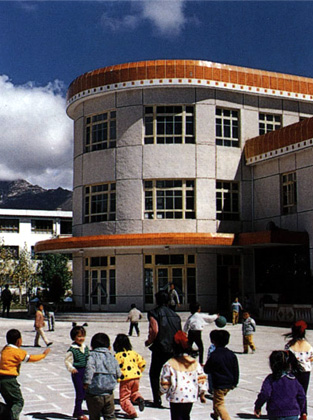the provision
of undergraduate studies and professional training with
a view to training scientists, technicians, educators
and art and literary talent for ethnic groups. This period
saw a fairly rapid development of EEMP.
During
the chaotic"cultural revolution" (1966-76),
the peculiarity of EEMP was denied, EEMP administrative
organs at different levels were abolished, and nationalities
institutes and nationalities middle and primary schools
were forced to stop functioning or disband. It was not
until 1976 when the "cultural revolution" (1966-76)
ended that EEMP went back on the normal track of development.
In the
early 1980s, various ethnic minority autonomies, in accordance
with the requirements of local economic development, made
adjustments in ways and principles of running EEMP schools
as well as the scale and speed of EEMP development; administrative
organs for EEMP were restored; central
and local finances resumed support for EEMP; ethnic
minority autonomies restored and strengthened ethnic minority
language teaching; restored nationalities institutes resumed
preparatory classes for higher education; and ethnic minority
teachers received training in various forms.
In the
process of reform and development, EEMP has gradually
developed a complete educational system consisting of
elementary education, higher education, |
|
 vocational education and adult education. The system includes
not only pre-school classes, primary schools, secondary
schools and institutions of higher learning run by ethnic
minority autonomies but also ethnic minority primary schools,
EM secondary schools, EM secondary technical schools and
nationalities institutes that are located outside ethnic
minority autonomies but enroll mainly ethnic minority
students. Take for example the Tibet Autonomous Region,
where no school in a modern sense existed in the past.
After 50 years, three-year compulsory education has been
made universal in pastoral areas, six-year compulsory
education in agricultural areas, and nine-year compulsory
education in major cities and towns. The rate of illiteracy
among young and middle-aged people dropped from 95 percent
before 1951 to 42 percent in 1999. Today, there are in
Tibet 820 primary schools, 101 middle schools, 16 secondary
technical schools and four institutions of higher learning.
vocational education and adult education. The system includes
not only pre-school classes, primary schools, secondary
schools and institutions of higher learning run by ethnic
minority autonomies but also ethnic minority primary schools,
EM secondary schools, EM secondary technical schools and
nationalities institutes that are located outside ethnic
minority autonomies but enroll mainly ethnic minority
students. Take for example the Tibet Autonomous Region,
where no school in a modern sense existed in the past.
After 50 years, three-year compulsory education has been
made universal in pastoral areas, six-year compulsory
education in agricultural areas, and nine-year compulsory
education in major cities and towns. The rate of illiteracy
among young and middle-aged people dropped from 95 percent
before 1951 to 42 percent in 1999. Today, there are in
Tibet 820 primary schools, 101 middle schools, 16 secondary
technical schools and four institutions of higher learning.
|